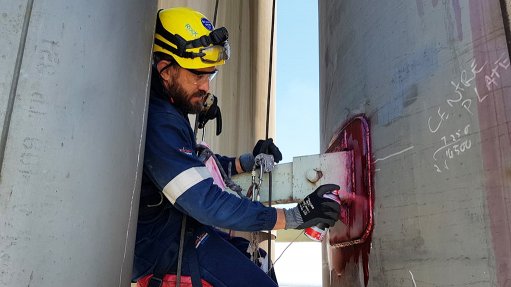
HIGH ROLLER NDT comprises a number of techniques that enables Skyriders to evaluate and test the integrity of a structure, component or system
Rope access specialist Skyriders provides non-destructive testing (NDT) for a large petrochemicals producer in South Africa.
“NDT comprises a number of techniques that enable us to evaluate and test the integrity of a structure, component or system without having to physically damage or take apart the item or structure that is being tested,” explains Skyriders marketing manager Mike Zinn.
The company specialises in four types of NDT – magnetic particle testing, liquid penetrant testing, ultrasonic testing and visual testing.
“Most commonly, we carry out ultrasonic NDT on boiler pressure parts to measure the wall thickness of highly pressurised systems. This allows for preventive maintenance if there are any discrepancies in the wall thickness.”
Zinn explains that, on petrochemicals storage tanks, a combination of visual inspections and ultrasonic wall-thickness tests provide effective results in the often highly corrosive environments where height and/or confined space is a limitation.
“By law, pressurised vessels, need to be assessed at regular intervals.”
He adds that, when conducting NDT during the maintenance process, Skyriders often conducts an initial visual inspection using one of its drones to evaluate if there are any problems. Thereafter, the professional rope access inspection teams can carry out more in-depth inspections and NDT and where necessary, any maintenance. Once the maintenance has been completed, Skyriders can conduct additional NDT to ensure that the maintenance has been done thoroughly as per the client’s expectations.
With rope access and NDT, the inspection and preventive maintenance can be realised quickly and at a more cost-effective rate than erecting the more traditional means of access such as scaffolding.
“We have seen many clients make the switch to using rope access, owing to its cost effectiveness and flexibility. Additionally, our small teams adhere to safety regulations as has been stipulated during the pandemic,” concludes Zinn.